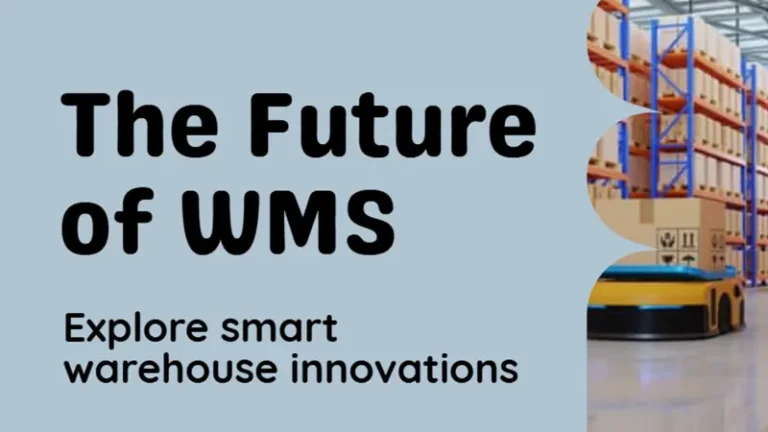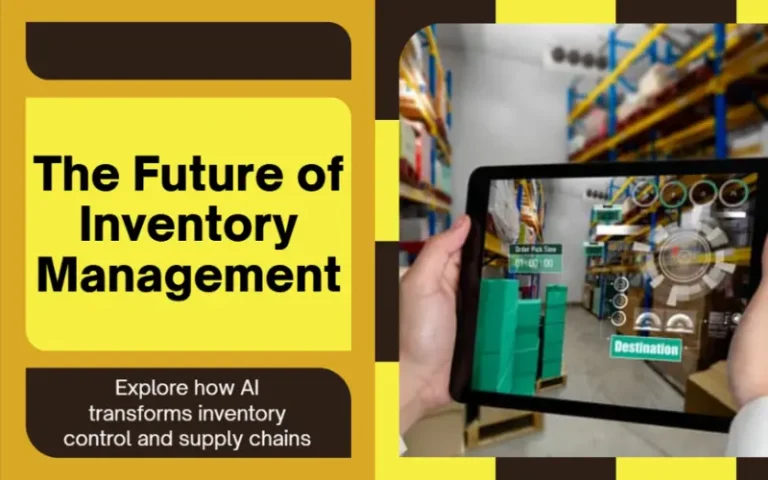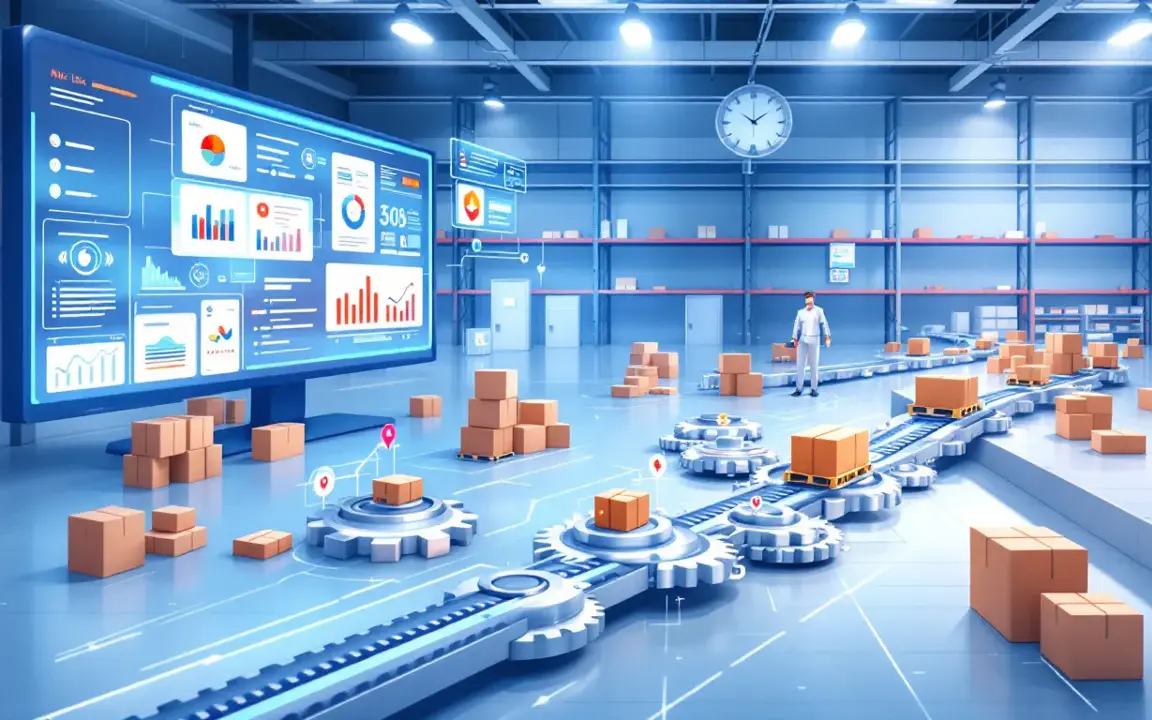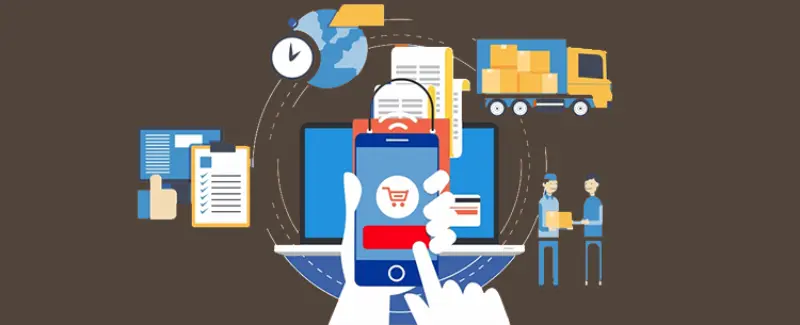The Future of Order Management Systems
In this article
 8 minutes
8 minutes
- From Transaction Tracker to Command Center
- AI That Anticipates, Not Just Automates
- The Rise of Distributed Order Management
- Zero-Touch Orders and Exception Management
- Voice-First, Hands-Off Order Control
- Real-Time Data for Smarter Decisions
- Preparing for the Next Wave
- Practical Takeaways for Businesses
- Frequently Asked Questions
Order management systems aren’t back-office utilities anymore. They’ve become the nerve center of modern commerce, where speed, accuracy, and customer experience converge. I’ve seen this transformation first-hand, and it’s only accelerating.
Slash Your Fulfillment Costs by Up to 30%
Cut shipping expenses by 30% and boost profit with Cahoot's AI-optimized fulfillment services and modern tech —no overheads and no humans required!
I'm Interested in Saving Time and MoneyFrom Transaction Tracker to Command Center
Order management used to mean tracking orders through a linear process: take the order, ship the order, close it out. That’s ancient history. Today’s environment demands agility across multiple channels, touchpoints, and partners. The future of order management systems (OMS) is about orchestration, not record-keeping. Modern order management software is now selected to streamline order processing, improve ecommerce operations, and integrate with customer service platforms to reduce delays and bottlenecks.
Modern OMS platforms provide real-time visibility into every order, regardless of where it originated. They handle online, in-store, marketplace, and wholesale orders seamlessly. Order entry is the crucial first step in capturing and processing customer orders, especially when customers order online, initiating the entire order tracking and fulfillment process. When I first worked on an omnichannel implementation, I realized how transformative a unified system could be. Customers could buy online and return in-store, track shipments in real-time, and get accurate delivery promises because the OMS had a live view of inventory and fulfillment options, allowing customers to access real-time inventory and order information, which enhances their overall experience. This single source of truth is becoming non-negotiable.
AI That Anticipates, Not Just Automates
The big leap forward is AI-driven intelligence. It’s no longer enough for an OMS to simply process orders efficiently. Modern systems automate and eliminate manual processes, significantly reducing the risk of human error and improving overall accuracy. The best systems now predict issues and solve them proactively.
Take order routing. Instead of static rules (“ship from warehouse closest to the customer”), AI evaluates inventory levels, shipping costs, carrier reliability, and even weather patterns to decide the optimal fulfillment plan for each order. One client I worked with shaved 12% off logistics costs simply by letting their OMS dynamically reroute orders to the most efficient fulfillment nodes. That’s not luck, that’s machine learning working in the background.
This intelligence also extends to customer satisfaction. A strong OMS will notice patterns like repeat order delays from a specific supplier or region and flag them before customers complain. Automated workflows streamline processing orders and minimize manual intervention, further reducing manual processes and the chance of human error. It can prompt proactive outreach: “We’ve identified a potential delay on your order, and here’s a faster alternative.” When you can prevent problems rather than apologize for them, you elevate the customer experience and loyalty.
The Rise of Distributed Order Management
Single-site fulfillment can’t keep up with today’s expectations. Distributed order management (DOM), sourcing and shipping from multiple locations, is becoming standard. A future-ready OMS treats inventory across warehouses, stores, and partner networks as one virtual pool, choosing the best fulfillment point automatically. It supports multiple warehouse locations and distribution centers, optimizing order fulfillment by streamlining inventory management and shipping across all sites.
This is where integration shines. When your OMS is connected to your inventory management and warehouse management systems, as well as external networks like Cahoot, it can route orders dynamically, selecting the best fulfillment center or fulfillment location for each order to ensure efficient order fulfillment. I’ve seen setups where an order placed in Chicago is fulfilled by a partner warehouse in Milwaukee for same-day delivery, without anyone manually intervening. That’s the future: speed, efficiency, and customer delight without adding complexity for the team running it.
Zero-Touch Orders and Exception Management
The dream scenario? Orders that process themselves. We’re closer than you might think. Advanced OMS platforms are reducing human intervention to the exceptions only. Standard orders, the bulk of them, flow from capture to delivery confirmation automatically. The OMS automates the fulfillment process and streamlines order fulfillment processes, ensuring efficient and accurate handling from start to finish.
I’ve experienced this shift in real-time. Early in my career, teams spent hours manually splitting orders, resolving inventory mismatches, and chasing tracking numbers. Now, modern OMS systems handle all that, minimizing human errors and optimizing the process of fulfilling orders. The role of the warehouse staff is to monitor overall health metrics and step in when something truly unusual happens. This “zero-touch” model saves labor, reduces errors, and speeds up fulfillment, all critical for competitive advantage.
Looking for a New 3PL? Start with this Free RFP Template
Cut weeks off your selection process. Avoid pitfalls. Get the only 3PL RFP checklist built for ecommerce brands, absolutely free.
Get My Free 3PL RFPVoice-First, Hands-Off Order Control
“Zero-touch” isn’t the endgame; zero-interface is. Future OMS platforms won’t just automate order flows; they’ll make managing exceptions as easy as speaking a sentence. Picture this: a major order needs rerouting due to a weather delay. Instead of diving into a dashboard, you simply say, “OMS, reroute all Chicago orders to St. Louis fulfillment for the next 48 hours”. Done. With new feature functionality, OMS platforms empower customer service teams to respond quickly and efficiently to customer needs, ensuring seamless support and adaptability as requirements evolve.
This is more than convenience, it’s about scale. When you’re processing tens of thousands of orders across multiple channels, reducing manual clicks saves hours, prevents errors, and frees your team for proactive customer work, including enabling customers to manage their orders and returns independently through self-serve options. Combined with AI-driven insights (“Three suppliers are trending late; would you like to switch sourcing?”), a zero-UI OMS becomes not just a tool, but a silent partner in delivering on customer promises.
Real-Time Data for Smarter Decisions
Like inventory management, order management thrives on real-time data analytics. Accurate, timely data enables better forecasting, resource allocation, and customer communications. A well-implemented OMS integrates seamlessly with ERP, CRM, and analytics platforms, turning order data into actionable insights. With access to customer data, sales data, and financial data, businesses can forecast inventory needs more accurately and track success across operations. You can spot trends like rising returns in a product category or underperforming carriers and act quickly.
One of my favorite features in newer OMS solutions is predictive order promising. Rather than guessing or padding delivery dates, the system calculates realistic estimates based on current inventory, capacity, and transit conditions. Customers get reliable ETAs, and businesses avoid overpromising. It’s a subtle shift that has a huge impact on trust and satisfaction.
Preparing for the Next Wave
Looking ahead, OMS platforms will continue to absorb more functionality. Expect deeper integrations with supply chain visibility tools, AI-driven fraud detection, and even sustainability modules (like carbon tracking per shipment). We’ll also see “headless” OMS models that decouple the backend logic from the front-end experience, making it easier to support new channels and interfaces. These advancements are essential for supporting business growth and meeting the evolving needs of ecommerce businesses, helping ecommerce business owners streamline operations and stay competitive.
The endgame? OMS is an intelligent hub that ensures every order, no matter how complex, is fulfilled in the fastest, most efficient, and most customer-friendly way possible, while aligning with specific business needs and supporting the scalability required for a growing ecommerce business.
Scaling Made Easy: Calis Books’ Fulfillment Journey
Learn how Calis Books expanded nationwide, reduced errors, grew sales while cutting headcount, and saved BIG with Cahoot
See Scale JourneyPractical Takeaways for Businesses
- Unify your channels: A single order management system (OMS) managing all sales channels is essential for operational efficiency and customer satisfaction.
- Evaluate and select the right order management solution: Work with order management solution vendors to choose the right order management system that fits your business needs and supports scalability.
- Integrate with accounting software: Connect your order management system OMS with accounting software to automate accounts payable, streamline invoice processing, and consolidate financial data.
- Streamline fulfillment and reduce shipping delays: Use your OMS to streamline fulfillment, optimize the order fulfillment process, and minimize shipping delays for timely delivery and improved customer satisfaction.
- Leverage third-party logistics and multiple sales channels: Enhance your order management process and order processing by integrating third-party logistics providers and managing inventory across various sales channels.
- Adopt AI-powered routing: Start leveraging OMS platforms with intelligent routing to cut costs and improve delivery speed and delivery timelines.
- Plan for distributed fulfillment: Integrate your OMS with partners and multiple locations for faster, more flexible delivery.
- Automate the routine: Configure your OMS to handle standard processes autonomously so your team can focus on exceptions and strategy.
- Focus on data quality: Real-time insights depend on clean, consistent data across systems; invest in getting it right.
Order management isn’t just a back-end function anymore. It’s a direct driver of customer experience, efficiency, and growth. The future belongs to businesses that treat OMS as a strategic asset and equip it with the intelligence and reach to deliver on that promise. Order management systems typically include features to track orders, manage the order process, and ensure efficient delivery timelines, making them essential for modern ecommerce and retail operations.
Frequently Asked Questions
What are the key trends shaping the future of order management systems?
Omnichannel integration, AI-driven routing, distributed order management, real-time data analytics, and increasing automation are the major trends.
How does AI improve order management?
It enables smarter routing, predictive order promising, proactive issue detection, and automation of routine tasks, reducing costs and boosting customer satisfaction.
What is distributed order management?
It’s the ability to fulfill orders from multiple locations, treating all inventory sources as a single virtual pool for faster, more efficient delivery.
How does OMS impact customer satisfaction?
By ensuring accurate inventory visibility, reliable delivery estimates, proactive communication, and flexible fulfillment options.
What should companies do now to prepare for the future of OMS?
Implement a unified, AI-capable OMS, integrate it with other core systems, automate routine tasks, and build partnerships for distributed fulfillment.
Turn Returns Into New Revenue
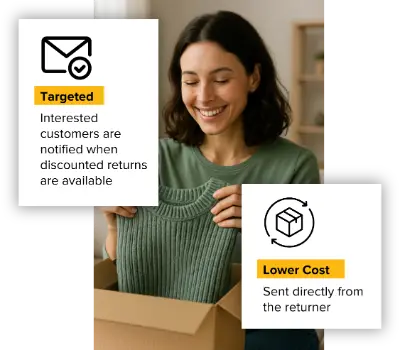
Top Strategies for Effective Inventory Management in 2025
In this article
 16 minutes
16 minutes
- Key Takeaways
- Understanding Inventory Management
- Types of Inventory
- Inventory Management Techniques
- Inventory Management Systems
- Demand Planning and Forecasting
- Inventory Control Best Practices
- Technology in Inventory Management
- Industry-Specific Inventory Management Tips
- Future Trends in Inventory Management
- Summary
- Frequently Asked Questions
Inventory management involves overseeing stock to meet customer demand while minimizing costs. Effective inventory management keeps businesses running smoothly.
In this article, you’ll discover key strategies for mastering inventory management in 2025. We’ll explore inventory management concepts, inventory role, inventory management objectives, inventory types, systems and controls of inventory management, technology considerations, best practices and industry tips in inventory management, planning and forecasting demand, future trends and possible predictions, and more.
Key Takeaways
- Effective inventory management is crucial for balancing customer demands with storage costs, helping to optimize the supply chain and minimize waste.
- Different inventory types—raw materials, work-in-progress, and finished goods—require unique management strategies to ensure efficiency and meet demand.
- Emerging technologies like AI, RFID, and cloud-based solutions are transforming inventory management, enhancing visibility, accuracy, and responsiveness.
Slash Your Fulfillment Costs by Up to 30%
Cut shipping expenses by 30% and boost profit with Cahoot's AI-optimized fulfillment services and modern tech —no overheads and no humans required!
I'm Interested in Saving Time and MoneyUnderstanding Inventory Management
Inventory management is pretty much the backbone of any successful business operation. At its core, it’s all about overseeing and controlling the ordering, storage, and use of components that a company uses in the production of the items it sells. This means managing stock levels, integrating with business operations, and tracking the flow of products from suppliers to customers—essentially, all the key inventory management processes.
So, why is inventory management such a big deal? Well, it helps balance what customers expect with what you can store and afford, ensuring that you don’t end up with too much or too little of what you need. Poor inventory management can lead to wasted time, resources, and money, which can really hurt a company’s financial health. But when inventory management is done right, it keeps the supply chain humming along smoothly, giving you visibility into procurement, production, and fulfillment processes.
And let’s not forget how logistics and inventory management are like best buddies. Efficient logistics heavily depend on accurate inventory data to meet customer demands quickly. Inventory management goes beyond just tracking stock; it’s about optimizing the entire supply chain to boost business performance.
The Role of Inventory in Business Operations
Inventory plays a huge role in various business functions, influencing both production efficiency and sales effectiveness. By analyzing sales data across different channels, businesses can forecast demand accurately, ensuring they have enough inventory to meet customer needs. This not only streamlines the production process but also enhances sales effectiveness, positively impacting overall business performance.
Material Requirements Planning (MRP) is another critical aspect, helping determine inventory needs based on expected demand. MRP streamlines the inventory process by ensuring that businesses have the necessary materials ready for production, reducing the risk of production delays and inefficiencies.
In a nutshell, effective inventory management aligns inventory levels with business operations, fostering a more efficient and responsive supply chain, highlighting the benefits of inventory management.
Key Objectives of Inventory Management
The main goal of inventory management is to find that sweet spot between having enough stock and keeping inventory investment low. This means keeping just enough stock to satisfy customer demand while avoiding excess inventory that ties up capital and racks up storage costs. Hitting this balance is crucial for optimizing stock levels and boosting cash flow.
Effective inventory management aims to cut losses and improve operational efficiency by minimizing excess stock. Proper inventory control ensures that businesses maintain the right stock levels, keep costs in check, and steer clear of overstocking or stockouts. Ultimately, the goal is to support smooth and continuous business operations and meet customer expectations.
Types of Inventory
Different types of inventory must be managed effectively, including raw materials, work-in-progress (WIP), and finished goods. Each type plays a unique role in the production process and requires specific management strategies.
Let’s dive into each type to understand their significance and management better.
Raw Materials
Raw materials are the basic building blocks used in the manufacturing process, essential for creating finished products. These can range from unprocessed items to components that need a bit of processing. Managing raw materials involves keeping track of these components to make sure they’re ready for production schedules. For example, Material Requirements Planning (MRP) helps businesses by ensuring they have the right amount of material for production, minimizing the risk of shortages.
Effective raw materials management also involves balancing ordering costs with holding costs to minimize overall inventory expenses. The Economic Order Quantity (EOQ) approach is particularly handy here, as it helps businesses save on costs by figuring out the most economical order size to meet demand without overstocking.
Accurate demand planning is key to aligning production and distribution, thereby minimizing both shortages and excess inventory.
Work-in-Progress (WIP)
Work-in-progress (WIP) inventory includes partially finished goods that are still going through the manufacturing process. Managing WIP inventory is necessary for ensuring a smooth and continuous production cycle, helping meet customer demand effectively.
However, balancing material availability with production timelines can be tricky, making it essential to monitor and manage WIP inventory closely to avoid production delays.
Finished Goods
Finished goods are products that have completed all stages of production and are ready for sale. Effective management of finished goods inventory is essential for meeting customer demand and minimizing missed sales opportunities. Aligning inventory levels with actual sales patterns through effective demand planning helps to avoid excess inventory and stockouts.
Proper management of finished goods involves maintaining optimal stock levels to ensure products are available when customers need them. This not only helps improve cash flow by reducing excess inventory but also enhances customer satisfaction by ensuring timely delivery of products and maintaining safety stock.
Inventory Management Techniques
Several inventory management techniques are available for optimizing stock levels and ensuring product availability. The most common techniques include Just-In-Time (JIT), Economic Order Quantity (EOQ), and ABC analysis. Each technique offers unique benefits and can be tailored to suit different business needs and operational goals.
Just-In-Time (JIT)
Just-In-Time (JIT) inventory management focuses on maximizing efficiency. It aims to lower costs by ensuring that inventory arrives just as production begins. This technique helps businesses avoid having more storage space for inventory than necessary, thereby reducing waste and lowering overall costs. Successful JIT inventory management requires proper forecasting of needs and close relationships with dependable suppliers to ensure timely deliveries.
JIT helps businesses reduce carrying costs and respond swiftly to market changes, avoiding the retention of unused goods and maintaining balanced inventory levels.
Economic Order Quantity (EOQ)
The Economic Order Quantity (EOQ) is a formula. It calculates the optimal order size needed to meet customer demand while staying within budget. The primary objective of EOQ is to minimize over-ordering and waste. Additionally, it aims to reduce storage costs and maximize quantity discounts. This approach is particularly useful when demand, ordering, and holding costs are high, helping businesses minimize overall inventory expenses.
EOQ enables businesses to save costs and maintain the right inventory levels, essential for efficient operations and optimized cash flow.
ABC Analysis
ABC analysis categorizes inventory items based on their importance, helping businesses prioritize management efforts. This technique involves dividing inventory into three classes—A, B, and C—based on value and turnover rate, enabling focused management strategies.
Retailers can use ABC analysis to categorize inventory based on sales volume or profitability, helping prioritize stock management and ensure that high-value items are always in stock.
Inventory Management Systems
An inventory management system is a crucial tool for tracking inventory stock levels and movements. These systems provide real-time visibility into stock across multiple locations, helping businesses manage inventory more effectively.
Critical features in inventory control software include integration with existing systems, additional functionality, and scalability.
Perpetual vs. Periodic Inventory Systems
Perpetual inventory systems provide continuous and immediate updates of inventory numbers, allowing businesses to have immediate access to stock levels, which informs decision-making. Automation and inventory management software assist retailers in tracking stock levels and accurately forecasting demand, complementing the advantages of perpetual inventory systems. However, one challenge of perpetually maintaining inventory records is that they may not accurately reflect the physical stock over time, leading to discrepancies.
On the other hand, periodic inventory systems require manual labor and can disrupt normal business activities. These systems are more prone to fraud due to reliance on less frequent stock counts. While periodic systems might be simpler to implement, they lack the real-time accuracy and efficiency of perpetual systems.
Choosing the Right Inventory Management System
When selecting inventory management software, consider the user experience and the learning curve associated with the system. Scalability is also crucial to ensure that the software can grow alongside your business needs. Integrating inventory management systems with point-of-sale technology helps retailers maintain accurate stock levels in real time.
Selecting the right inventory management system is essential for optimizing stock levels and improving operational efficiency. Factors to consider include the products managed, critical features needed, budget, and the ability to integrate with existing systems. Ensuring that your current staffing situation can support the new software is also important.
Looking for a New 3PL? Start with this Free RFP Template
Cut weeks off your selection process. Avoid pitfalls. Get the only 3PL RFP checklist built for ecommerce brands, absolutely free.
Get My Free 3PL RFPDemand Planning and Forecasting
Demand planning and forecasting are vital components of effective inventory management. By anticipating sales and timing for stock, businesses can prevent obsolete inventory from piling up and ensure they have the optimal mix of profit margin and sales volume.
Real-time inventory visibility provided by technology helps businesses respond to supply and demand changes more effectively.
Demand Forecasting Techniques
Historical sales data is a key component in determining customer demand trends for inventory forecasting. In retail, regularly analyzing sales data allows businesses to adjust inventory levels according to shifting consumer demand. Predictive AI enhances inventory management by enabling more accurate demand forecasting through the analysis of various data inputs. Additionally, qualitative forecasting incorporates subjective insights like market conditions and promotional events to enhance accuracy.
Identifying and accounting for demand outliers is crucial to avoid skewed inventory forecasts. Real-time updates in cloud-based systems help prevent stockouts and overstock situations, ensuring that inventory levels are always aligned with current demand.
Reorder Point (ROP)
The reorder point is the inventory level at which a new order should be placed to prevent stockouts. Calculating the reorder point involves considering lead time and the average daily usage of the inventory item. This formula is designed to trigger replenishment orders before stock depletes, thus avoiding stockouts and ensuring continuous product availability.
Inventory Control Best Practices
Effective inventory control is crucial for ensuring that the right products are available in the right quantities, avoiding both overstocking and stockouts. Different methods such as JIT, EOQ, and ABC analysis help in optimizing stock levels and managing costs.
Technology enhances inventory management by automating tasks, increasing accuracy, and reducing errors. Implementing robust procedures helps businesses manage costs associated with excess inventory and missed sales opportunities.
Regular Stock Audits
Regular physical inventory counts are essential to maintain accurate records and ensure inventory integrity. To enhance accuracy, regular physical inventory counts should complement a perpetual inventory system.
This practice helps identify discrepancies between recorded and physical stock, ensuring that inventory data remains accurate and reliable.
Vendor Managed Inventory (VMI)
Vendor Managed Inventory (VMI) improves inventory accuracy by allowing suppliers to manage stock levels more effectively. Implementing VMI enhances supplier relationships due to increased reliability in supply chains. This approach aligns closely with Just-In-Time (JIT) practices, emphasizing timely deliveries and improved supplier communication.
The overall impact of VMI on inventory management includes improved accuracy, efficiency, and stronger partnerships with suppliers. By allowing suppliers to manage inventory, businesses can focus on other critical areas while ensuring that stock levels remain optimal.
Inventory Optimization Strategies
Balancing inventory levels through optimization strategies minimizes carrying costs while meeting customer demand. JIT focuses on minimizing inventory storage, significantly lowering storage-related expenses. Assessing market trends and customer behavior is key to refining inventory optimization techniques.
Effective inventory optimization strategies involve using advanced techniques and technologies to forecast demand accurately and manage stock levels efficiently. These strategies ensure that businesses maintain just the right amount of inventory to meet customer needs without incurring unnecessary costs.
Technology in Inventory Management
Let’s talk about how technology is shaking things up in inventory management. With the rise of AI, RFID, and IoT, businesses are finding smarter ways to keep track of their stock. These tech tools are game-changers, offering real-time updates and automating the restocking process, which makes everything run smoother and more efficiently.
By weaving advanced technologies into the mix, inventory management is becoming more flexible and ready to adapt to whatever the business world throws at it.
Barcode and RFID Technology
When it comes to tracking inventory, barcode and RFID technology are like your trusty sidekicks. Barcodes help keep tabs on parts and where they’re hanging out, while RFID tags are like the superheroes of inventory tracking—especially the passive ones that don’t even need batteries! These tools are a big win for small businesses looking to cut down on costs.
By adding barcode and RFID tech into the inventory mix, businesses can keep their data spot-on, streamline operations, and cut down on those pesky manual errors. It’s all about working smarter, not harder.
Cloud-Based Inventory Solutions
Cloud-based inventory systems are like having your inventory at your fingertips, no matter where you are. They let businesses keep an eye on stock from any device, making it easy to adjust as needed. Plus, with real-time tracking, you’re always in the know about your inventory levels and can keep them in line with demand.
These cloud solutions are all about flexibility, letting businesses manage their stock remotely and make quick, informed decisions. This tech really steps up inventory management by giving you a clear view of your stock, boosting efficiency, and helping avoid those dreaded stockouts or overstock situations.
Industry-Specific Inventory Management Tips
Every industry has its own quirks when it comes to managing inventory, so tailoring your approach can really pay off. Whether you’re in retail, manufacturing, or healthcare, understanding the unique challenges and needs of your industry is key to nailing inventory management.
Here are some tips to help you optimize inventory practices for your specific industry.
Retail Inventory Management
In retail, it’s all about making sure the shelves are stocked with what customers want. This means setting the right prices and keeping just enough inventory to meet demand without breaking the bank on storage.
By using sales data to forecast demand, retailers can keep their stock levels just right and avoid overstocking.
Manufacturing Inventory Management
For manufacturers, it’s crucial to have enough stock to keep production lines humming along. Effective management means having a clear view of stock levels and keeping tabs on raw materials, parts, work-in-progress, and finished goods.
Timing is everything here—scheduling raw materials to match up with production cycles helps avoid delays and keeps things running smoothly.
Healthcare Inventory Management
In healthcare, inventory management is all about making sure medical supplies are available when needed, while also sticking to strict regulations. Specialized systems help track inventory across different locations, so there’s no shortage of critical supplies.
Keeping a close eye on medical inventory helps minimize waste and ensures that essential supplies are always ready for use. Timely restocking is key to maintaining top-notch patient care and staying compliant with regulations.
Future Trends in Inventory Management
Looking ahead, there are some exciting trends on the horizon for inventory management. As inventory demands grow, finding ways to maximize warehouse space and improve control practices is becoming more important than ever.
Let’s dive into some of the future trends that are set to shake up inventory management.
Artificial Intelligence and Machine Learning
AI and machine learning are like the secret weapons for inventory management, optimizing processes, and cutting down on mistakes. Machine learning is set to take forecasting to the next level, helping businesses predict demand more accurately and adjust inventory accordingly. Plus, generative AI can whip up new data insights to help managers stay ahead of market changes.
With agentic AI making real-time decisions, like tweaking reorder points based on demand, inventory management is poised for a major upgrade, becoming more efficient and responsive to market shifts.
Blockchain for Supply Chain Transparency
Blockchain technology is like a super-secure digital ledger that can bring a whole new level of transparency to supply chains. By offering a clear view of goods as they move, it helps all parties make better decisions. Plus, blockchain’s transparency and security features help cut down on fraud and keep supply chains running smoothly.
Over time, blockchain is expected to enhance inventory visibility and accuracy, ensuring that inventory data is both reliable and tamper-proof.
Scaling Made Easy: Calis Books’ Fulfillment Journey
Learn how Calis Books expanded nationwide, reduced errors, grew sales while cutting headcount, and saved BIG with Cahoot
See Scale JourneySummary
To sum it all up, effective inventory management in 2025 is all about blending smart strategies, cutting-edge tech, and industry-specific practices. From the basics to using AI and blockchain, businesses have plenty of tools to fine-tune their inventory processes. By balancing stock levels, keeping costs low, and boosting visibility, companies can create more efficient and responsive supply chains.
As we look to the future, embracing new technologies will be crucial for staying competitive and meeting the ever-changing demands of the market. By taking these insights and strategies on board, businesses can build a more efficient, resilient, and successful inventory management system.
Frequently Asked Questions
What is the primary goal of inventory management?
The primary goal of inventory management is to ensure you have enough stock on hand to satisfy customer demand while minimizing your investment in inventory. Striking this balance is key to running a successful business.
How does Just-In-Time (JIT) inventory management work?
Just-In-Time (JIT) inventory management works by synchronizing inventory delivery with production schedules, ensuring that materials arrive exactly when needed. This approach helps minimize waste and reduce storage costs. It’s all about efficiency and keeping your operation lean!
What are the benefits of using AI in inventory management?
Using AI in inventory management can significantly optimize processes and improve forecasting accuracy, allowing you to make real-time decisions that align inventory levels with demand. This means less waste and better stock availability for your business!
How does Vendor Managed Inventory (VMI) improve inventory accuracy?
VMI boosts inventory accuracy by enabling suppliers to directly manage stock levels, which leads to better alignment with demand and improves overall efficiency. Plus, it fosters stronger relationships between suppliers and retailers.
What is the role of cloud-based inventory solutions?
Cloud-based inventory solutions are essential for real-time tracking, allowing you to manage your inventory efficiently from anywhere, anytime. They offer the scalability and flexibility that today’s businesses need.

Turn Returns Into New Revenue

In-House or Outsource Fulfillment: What’s Best for Your eCommerce Business
The decision to outsource fulfillment to a third-party logistics (3PL) provider can be a strategic move for e-commerce businesses. 3PLs expand your fulfillment capacity and can even give you a hands-free approach to fulfilling orders. However, selecting the right partner and managing the relationship effectively can be challenging. Many sellers have reported problems with their 3PL ranging from same-day cut-offs, SLA issues, difficulty reaching support, and disruptive management changes.
What if outsourcing your fulfillment to a 3PL or doing fulfillment out of your warehouse doesn’t necessarily need to be a binary decision? Merchants have sometimes tapped into the best of both worlds by doing both. We’ll explore that in today’s article.
What is the benefit of working with a 3PL?
Outsourcing fulfillment to a 3PL can offer numerous advantages for e-commerce sellers. Firstly, 3PLs possess the expertise and infrastructure to handle the entire fulfillment process efficiently and cost-effectively. They have access to state-of-the-art warehouses, transportation networks, and experienced staff, allowing them to optimize operations and minimize errors. Their operations are set to do general e-commerce fulfillment well, this could be a big benefit for sellers new to fulfillment.
Secondly, partnering with a 3PL can provide businesses with greater scalability and flexibility. 3PLs can easily accommodate fluctuations in demand, ensuring that orders are processed and shipped promptly, even during peak seasons. Having multiple warehouses is especially important for meeting customers’ fast delivery expectations. This frees up e-commerce sellers to focus on other core aspects of their business, such as marketing, product development, and customer acquisition.
Slash Your Fulfillment Costs by Up to 30%
Cut shipping expenses by 30% and boost profit with Cahoot's AI-optimized fulfillment services and modern tech —no overheads and no humans required!
I'm Interested in Saving Time and MoneyThe Challenges of Choosing a 3PL
The benefits of working with a 3PL is not without its downsides. Selecting the ideal 3PL involves careful evaluation and due diligence. Businesses often encounter several challenges in this process:
- Hidden Fees and Overcharging: Many businesses report being surprised by unexpected charges or higher-than-expected costs. It’s essential to obtain detailed pricing information upfront and be wary of hidden fees. Make sure to estimate your total cost of ownership when getting quotes from a 3PL. Blindly comparing rates across many 3PLs can also be misleading as fulfillment fees (and other line items) can include different things at different providers.
- Inventory Inaccuracies: Ensuring accurate inventory management is crucial for avoiding stockouts and customer dissatisfaction. Some 3PLs struggle with maintaining precise inventory records and sellers have reported losing inventory as a result.
- Communication Breakdowns: Effective communication is vital for a successful 3PL partnership. Businesses often encounter challenges in reaching customer support, receiving timely responses, and understanding complex pricing structures. Large, established 3PLs may find it difficult to provide personalized attention, and it can be challenging to get in touch with someone who can fully resolve your problems, such as storage fee errors or missing inventory in transit.
- Lack of Flexibility: 3PLs may be unable to accommodate specific business needs, such as custom packaging or specialized handling requirements, or even reasonable cut-off times. For example, one merchant reported that their 3PL had an 8 AM same-day cutoff, which is unacceptable for any business offering fast delivery.
- Management Changes: While not frequent, changes in management at a 3PL can bring major disruptions. This risk should be considered when selecting a partner.
Why should you not work with a 3PL?
While outsourcing to a 3PL can offer benefits, managing fulfillment in-house also has its advantages and disadvantages:
Pros:
- Greater Control: In-house fulfillment provides businesses with more control over their operations, including inventory management, shipping, and order fulfillment processes. This allows for better oversight and the ability to address customer questions and concerns more effectively.
- Potential Cost Savings: For some businesses, managing fulfillment internally can be more cost-effective, especially for smaller operations or those with unique requirements. For example, we have seen merchants that generate less than $1 million in annual sales and sell items for less than $10 often find savings when doing fulfillment on their own rather than outsourcing.
Cons:
- Scalability Challenges: Scaling up operations can be difficult, especially during peak seasons or periods of rapid growth.
Looking for a New 3PL? Start with this Free RFP Template
Cut weeks off your selection process. Avoid pitfalls. Get the only 3PL RFP checklist built for ecommerce brands, absolutely free.
Get My Free 3PL RFPHow to minimize risk when working with a 3PL?
To mitigate risks and ensure a successful 3PL partnership, consider the following strategies:
- Thorough Due Diligence: Conduct comprehensive research and reference checks before selecting a 3PL. This includes evaluating their reputation, experience, and client testimonials.
- Regular Monitoring and Audits: Conduct regular audits to ensure that the 3PL is meeting performance expectations and complying with agreements. This can include ordering a package to yourself periodically to assess packing quality and identify any issues.
Consider a Hybrid Approach
Sometimes the best method is to use both in-house and outsourced fulfillment. If you already run a warehouse for your e-commerce fulfillment, outsourcing can be used for extra capacity for your popular goods. This way you limit the “risk” of a 3PL being unfamiliar with your items by sending just a small set of SKUs. Or you can use the 3PLs to power fast delivery programs like Amazon Seller Fulfilled Prime, which can then be leveraged to offer fast shipping on all channels.
The downside of doing a hybrid approach is additional complexity in determining which warehouse to ship an order as most popular shipping software today is designed for single warehouse fulfillment. To minimize this downside, you can use fulfillment networks like Cahoot that have integrated software and fulfillment service solutions built for hybrid models.
Scaling Made Easy: Calis Books’ Fulfillment Journey
Learn how Calis Books expanded nationwide, reduced errors, grew sales while cutting headcount, and saved BIG with Cahoot
See Scale JourneyConclusion
Choosing the right 3PL and managing the partnership effectively is crucial for e-commerce businesses. By understanding the challenges, evaluating the pros and cons of in-house fulfillment, and implementing strategies to overcome common issues, businesses can establish successful partnerships that drive growth and improve operational efficiency.

Turn Returns Into New Revenue

Shoptalk Spring
In this article
 1 minute
1 minute
March 24-27, 2025 | Mandalay Bay, Las Vegas
Shoptalk is the ultimate gathering of retail, where 10,000+ retail decision-makers converge to discover the future of retail. Get ready for three action-packed days that will expand your horizons and catapult your business forward.
Slash Your Fulfillment Costs by Up to 30%
Cut shipping expenses by 30% and boost profit with Cahoot's AI-optimized fulfillment services and modern tech —no overheads and no humans required!
I'm Interested in Saving Time and Money
Turn Returns Into New Revenue

Shoptalk 2024
In this article
 1 minute
1 minute
Mar 17-20, 2024 | Mandalay Bay, Las Vegas, NV
Join the industry’s elite at Shoptalk, the ultimate gathering of retail’s top 10,000+ executives. Held annually in Las Vegas, Shoptalk is an unprecedented gathering of individuals and companies reshaping how consumers discover, shop and buy.
The event provides a platform for large retailers and branded manufacturers, startups, tech companies, investors, media and analysts to learn, network, collaborate and evolve. Pulse Commerce hopes to see you there! You can register here.
Slash Your Fulfillment Costs by Up to 30%
Cut shipping expenses by 30% and boost profit with Cahoot's AI-optimized fulfillment services and modern tech —no overheads and no humans required!
I'm Interested in Saving Time and Money
Turn Returns Into New Revenue

Shoptalk 2023
In this article
 1 minute
1 minute
Mar 26-29, 2023 | Mandalay Bay, Las Vegas, NV
The world’s biggest, most influential and rising retailers and brands unite at Shoptalk for unrivaled business-critical connections, conversations, insights and extraordinary shared experiences to re-imagine the future together.
The Shoptalk agenda covers the latest technologies, trends and business models, as well as the rapid transformation of what consumers discover, shop for and buy—everything ranging from apparel and electronics to beauty and grocery. We look forward to seeing you there! You can register here.
Slash Your Fulfillment Costs by Up to 30%
Cut shipping expenses by 30% and boost profit with Cahoot's AI-optimized fulfillment services and modern tech —no overheads and no humans required!
I'm Interested in Saving Time and Money
Turn Returns Into New Revenue

Shoptalk 2020
In this article
 1 minute
1 minute
Mar 22-25, 2019 | Mandalay Bay, Las Vegas, NV
Shoptalk is where 8,000+ retail changemakers come together every year to create the future of retail. For 5 years, They have defined the industry’s digital community by bringing established retailers and brands together with direct-to-consumer and tech startups, large tech and Internet companies, venture capital investors, real estate developers, equity analysts, media and others.
The industry-defining agenda, world-class speaker lineup and unique networking and collaboration programs as well as newly introduced Shoptalk Original Content ensure you’ll get smart about the technologies, trends and business models that continue to transform the sector globally.
Register today to meet us there!
Slash Your Fulfillment Costs by Up to 30%
Cut shipping expenses by 30% and boost profit with Cahoot's AI-optimized fulfillment services and modern tech —no overheads and no humans required!
I'm Interested in Saving Time and Money

Turn Returns Into New Revenue

IRCE at RetailX 2020
In this article
 1 minute
1 minute
June 9-11, 2019 | McCormick Place, Chicago
Are you making your way to IRCE at RetailX in Chicago this year? Come meet us at our booth #809.
IRCE is your one-stop-shop for all your e-commerce needs. This conference and trade show offers you everything your business needs to stay ahead of your competition, in one simple location. IRCE @ RetailX will take place in the world-class city of Chicago, June 9-11, 2020. IRCE’s conference offers strategic educational sessions on the topics that matter to you most. With over 130 sessions covering various topics and trends, your needs are met at IRCE.
Slash Your Fulfillment Costs by Up to 30%
Cut shipping expenses by 30% and boost profit with Cahoot's AI-optimized fulfillment services and modern tech —no overheads and no humans required!
I'm Interested in Saving Time and Money
Turn Returns Into New Revenue

3 Strategies to Fulfill Like Amazon
If Amazon reduced shipping costs by just 1 percent, it would save $162 million. Amazon spent $16.2 billion on shipping in 2016. We can be certain that it is spending millions to improve and optimize its shipping processes. Ecommerce merchants can take advantage of Amazon’s efforts to increase profits.
Amazon’s 2016 shipping expense was 17.7 percent of direct ecommerce revenue. That’s $8.85 for every $50 order, which is achievable by most merchants.
This post, describes three strategies to fulfill like Amazon, even if you have a fraction of its scale and infrastructure
- Manage Carriers
- Manage Yourself
- More Choices, Urgency
Manage Carriers
Manage carrier contracts by the numbers. Negotiate better rates using data and analytics.
Analyze accessorial charges. These are extra fees assessed on top of the base rate. Compare every accessorial line item, by carrier, as a percentage of total shipping costs.
- Errors, such as address correction, return charge, and incorrect weight.
- Extra services, such as residential or rural delivery, remote area delivery, and Saturday delivery.
- Surcharges, including fuel charges, hazardous materials and international dangerous goods, and holiday season surcharges.
Analyze standard shipping fees for each cost driver.
- Distance, weight, volume.
- Size to weight ratio — e.g., dimensional weight surcharges for light (but big) items.
- Service level — e.g., next day air versus 5-day ground.
Negotiate like a pro.
- Focus on the accessorial fees that have hit you the hardest.
- Negotiate shipping fees with each carrier to match the lowest priced carrier for each category.
- Negotiate insurance fees with each carrier as well as with pure-play insurers.
Enforce each carrier’s service level agreement and negotiated prices.
- Validate that carrier bills are indeed reflecting your negotiated prices.
- File timely reimbursement claims for SLA violations — within 15 days, typically.
Automate intelligent carrier and service selection. In my experience, companies can save up to 25 percent on shipping costs from this strategy alone. No single carrier offers the best rates for every situation. The carrier that charges the least for an in-zone ground shipment may not be the one that charges the least for a 2-pound next day air delivery.
Create decision rules for choosing carriers and service types based on factors such as dimensional weight and delivery zone. Rather than attempting to cover every possibility, start by implementing the rules for 80 percent of your orders. Make sure to meet the minimum volume that you promised a carrier to secure your discounts and negotiated rates.
Implement these intelligent rules across all fulfillment centers and drop-ship vendors and then automate the selection process for your entire order management and warehouse management systems. Here are two examples.
- Geography-based rules. Shipper A charges the least for shipments from New York to Arizona while Shipper B charges the least for same-zone shipments.
- Weight-based rules. Shipper C charges the least for next-day air packages under two pounds.
Slash Your Fulfillment Costs by Up to 30%
Cut shipping expenses by 30% and boost profit with Cahoot's AI-optimized fulfillment services and modern tech —no overheads and no humans required!
I'm Interested in Saving Time and MoneyManage Yourself
Like Amazon, audit and analyze your own operations routinely to deliver orders faster and cheaper. This may seem obvious, but many mid-market retailers lack the technology and infrastructure. Your ecommerce systems should facilitate automated rules, in addition to answering the following questions:
- Which products are generating the highest discrepancies between the shipping fee invoiced to the customer versus what’s charged by the carrier?
- What is the best carrier for each product, order size, and geography?
- Which shipments resulted in missed carrier SLAs or actionable exceptions?
Eliminate costly errors. Accessorial charges are typically the result of errors. According to Refund Logistics, 31 percent of carriers’ invoices include these extra fees, on average. Common errors and resulting fees include:
- Incorrect address, resulting in address correction and return fees.
- Incorrect dimensions and weight, resulting in DIM charges, which can be eliminated by ensuring product catalog data is accurate.
Intelligent order routing. Route orders to the fulfillment center(s) closest to the customer.
- Ship faster and reduce shipping costs up to 25 percent.
- Pick the least expensive shipping type that gets the package to its destination within the promised delivery date commitment.
Go omnichannel. If you’re an ecommerce merchant with physical stores, leverage those stores as fulfillment centers.
- Ship from store. Shipping from stores can reduce shipping costs and speed up delivery. For example, Best Buy reduced average shipping time by two days with its ship from store program. Revenue may increase, too, with this strategy. American Apparel reported a 30 percent increase in sales from using stores as backup fulfillment centers.
- Buy online, pick up in-store. Offer pickup in-store as a delivery option for online customers. It eliminates shipping fees and increases customer satisfaction. Plus, customers spend an additional 20 percent, on average, when picking up their items.
Looking for a New 3PL? Start with this Free RFP Template
Cut weeks off your selection process. Avoid pitfalls. Get the only 3PL RFP checklist built for ecommerce brands, absolutely free.
Get My Free 3PL RFPMore Choices, Urgency
Offer more choices. Increase conversions by giving customers delivery options that provide greater certainty of delivery times. For example, Amazon offers these shipping choices:
- “Tuesday, Sept. 12: $5.99 One-Day Shipping.”
- “Wednesday, Sept. 13: Free Two-Day Shipping.”
- “Friday, Sept. 15: Free No-Rush Shipping + Get $5 Reward for Prime Pantry.”
Create urgency to increase conversions. On your product details, shopping cart, and checkout screens, show how much time is remaining to complete the order and still receive guaranteed delivery by the desired date.
If you are already implementing these techniques and are looking for more tips and tricks, check out this comprehensive guide to profitable free shipping

Turn Returns Into New Revenue

The Definitive Guide to Distributed Order Management System
In this article
 19 minutes
19 minutes
- I. Introduction
- II. The New Ecommerce and Retail Realities in the Age of Amazon Prime
- III. What is Distributed Order Management?
- IV. Distributed Order Management System Capabilities
- V. Omnichannel Commerce and Distributed Order Management – A Match Made in Heaven
- VI. Distributed Order Management Software Deployment Models
- VII. Distributed Order Management System Software Vendor Selection
- VIII. How to Calculate the ROI on Order Management Systems
- IX. Tips for Successful Distributed Order Management System Implementation
- X. Conclusion
I. Introduction
Almost every “next year’s retail trends” article includes omnichannel commerce as one of the potential saviors of non-Amazon retail as we know it. The conventional knowledge is that multichannel merchants’ only chance of surviving is to take advantage of their biggest assets, their stores, to deliver services that Amazon cannot. By combining the power of their stores and their ecommerce websites they can create a retail whole greater than the sum of its parts.
How can siloed commerce systems and processes transform into a unified platform — one that can deliver on the promise of omnichannel commerce? BPR’s Ken Morris’ perspective is that, “Retailers aren’t going to throw their legacy applications away, they’re not going to throw their investments away, but what they have to do is link it all in real time.” The solution: “The most important component is a middleware layer—a piece of software that connects the dots.”
Distributed Order Management System (DOM) is that middleware. Distributed Order Management is the unsung hero of omnichannel Retail Commerce, a hero rarely mentioned in articles about buy online pickup in store.
Continue reading to learn why distributed order management systems have taken on such an important role in retail innovation, and the practical implications for your business.
II. The New Ecommerce and Retail Realities in the Age of Amazon Prime
Amazon generated over 25% of all U.S. Retail growth in 2016[1], and their sales represented 5% – 6% of total U.S. retail sales. This one behemoth pushed all others aside to eat an outsized chunk of retail pie growth. Many analysts consider Amazon Prime to be a significant growth driver, with over 90mm Prime members[2] who have access to movies, e-books and photo storage, at no additional charge. Of course, free 2-day shipping is included too.
For perspective, at $99 per year, that’s $9B in Prime Membership revenue, before a single purchase is made on the site. Collectively, consumers with Prime Memberships have a $9b incentive to purchase on Amazon to take advantage of 2-day free shipping. The psychological pull is strong — “Why should I try to meet the $75 free shipping minimum on otherwebsite.com when I already have free shipping on Amazon?”
The new ecommerce realities are margin eaters. Over 90 million Prime consumers expect:
- Free and fast shipping options
- Date-certain delivery choices (Amazon typically offers 4 options)
- Frequent, accurate, multi-device order status updates (website, mobile, text)
- Frictionless returns
- Lower prices, with multiple merchants offering the same products on Amazon Marketplace
As a result merchants face new challenges. How can you capture your fair share of ecommerce growth, while also:
- Adding free shipping and multiple, date-certain delivery choices
- Providing frequent, accurate, order updates
- Offering simple returns and exchanges processes
- Holding prices in check
Meanwhile, many pure play ecommerce businesses are far more complex today than they were 15 years ago. The days of a single ecommerce storefront are long gone, with many pure-play ecommerce merchants also selling through marketplaces, including Amazon, to ride the coattails of their huge traffic. In terms of sourcing, merchants purchase from multiple vendors, and they’re also selling products fulfilled by drop-shippers.
Multichannel retailers with bricks and mortar storefronts entered the ecommerce fray quite a while ago. Their challenges are even more daunting. Sales channels no longer operate in silos. Many are seeking to offer omnichannel services that pure play ecommerce player like Amazon cannot (until recently). Buy online and pickup in the store; buy online and return to the store; inventory optimization across stores, ecommerce storefronts, and warehouses; persistent shopping carts that remain current as consumers move from the website to the mobile device to the store; ship from store. The list is growing.
The new reality is that the companies who are capable of creating omnichannel experiences for customers, to differentiate versus Amazon, are most likely the ones who will come out ahead in the retail shakeout currently underway. The merchants that consistently deliver stellar and consistent service as consumers shop across channels, and transform their sales channel silos into an integrated whole will be the winners.
[1] https://www.digitalcommerce360.com/2017/02/17/us-e-commerce-sales-grow-156-2016/
[2] http://www.businessinsider.com/amazon-prime-subscribers-chart-2017-10
III. What is Distributed Order Management?
We’ll define Distributed Order Management by first defining Order Management in the context of a simple ecommerce business with an online storefront and a single fulfillment center.
Order Management is the capture and processing of a customer order, followed by the assignment of that order to a fulfillment center or 3PL to pack and ship the item(s). Order management also includes reverse logistics (returns). In this simple case, there is only one location receiving returns, so tracking is straightforward, as is adding the item back into inventory.
Distributed Order Management (DOM) was born out of challenges that arose as ecommerce grew more complex. A DOM addresses the challenges that channel proliferation and rising expectations introduced. Many online-only businesses now sell through multiple channels – their own storefronts plus multiple marketplaces. Sourcing and fulfillment are more complex too, with products fulfilled by multiple warehouses, dropshippers, and 3PL’s.
New challenges are plentiful:
Challenge #1: With multiple sales channels, how do you ensure you only sells items that are in stock?
How does the ecommerce storefront evaluate whether an item in the shopping cart is still in stock? If the last item is sold through your storefront, will your marketplace stop selling the item? Or continue selling?
Challenge #2: How do you decide which fulfillment center should handle an order?
With orders coming in from multiple storefronts, and being distributed to multiple fulfillment centers, a new question emerges. Should you ship from the fulfillment center closest to the ship-to-address? Or to the fulfillment center with the highest days of inventory on hand? How will you handle an order that includes 2 items that are not in the same warehouse? What about an item that is out of stock, but on its way to the warehouse?
Challenge #3: Which carrier should be used to ship faster and cheaper?
Even with Amazon’s economies of scale, shipping costs were over 17% as a percent of their average order value in 2016. To keep shipping costs in check, which carrier should you use for a specific delivery — e.g. which one has the best price for 2-day guaranteed delivery from North Carolina to Texas?
Challenge #4 (and 5 and 6): Bricks and Mortar
Now add brick-and-mortar storefronts into the mix. How can you keep a real-time holistic pulse on inventory with orders coming in from online sources and items also being sold in stores? How can you squeeze synergy out of bricks and clicks? How can your store associates accept a return for an item purchased online? Will it be reflected in inventory? If an item is out of stock in your fulfillment center, can you sell it online and ship from a store? The questions, challenges and opportunities are endless.
Taking these questions a step further, If a retailer intends to deliver consistent experiences across all channels, and to put all of their inventory to work (e.g. an online order can be shipped from a store), complexity increases exponentially. Silo’d systems can’t possibly keep up.
A Distributed Order Management System processes orders from multiple sales channels and intelligently routes them to the ideal fulfillment center. Some can even select the ideal shipper, too. Orders are turned around faster and more accurately; inventory turns increase; shipping costs decrease. Implemented properly, the Order Management System squeezes more out of your prior commerce technology investments, unifying them to orchestrate streamlined operations, optimized inventory, faster order turnaround, and better cross-channel customer support.
IV. Distributed Order Management System Capabilities
An order management system resolves the challenges outlined above by:
- Synchronizing real time Order and Inventory data with all sales channels and fulfillment centers
- Processing orders from multiple sales channels (e.g. fraud checks, payment processing, address correction)
- Calculating the optimal fulfillment location based on priorities (e.g. closest to customer; fulfillment center with highest inventory)
- Routing the order to the ideal fulfillment center and maintaining up-to-date inventory information.
The distributed order management system also does far more. It not only routes the order, it prioritizes fulfillment of each order against the others, and manages back-orders and reservations for pre-launch products.
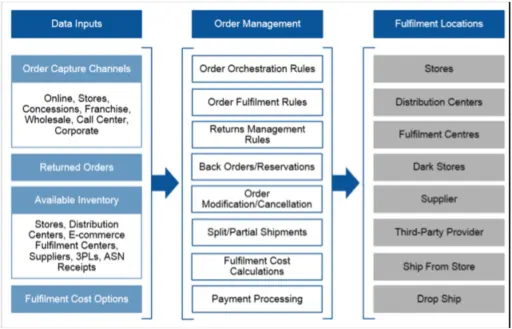
Source: Gartner Market Guide for Retail Distributed Order Management Systems, 2017
Capabilities include:
- Single data repository of all orders and all inventory from all retail channels and fulfillment centers, providing real-time inventory to POS, fulfillment, and ecommerce platforms. An enterprise DOM will also house customer order histories, and product and pricing information.
- Order acceptance from multiple sales channels, including marketplaces.
- Payment processing and checkout, including credit checks, fraud checks, payment authorization, tax and export duty calculations, and refund payment processing.
- Order routing to the ideal fulfillment center or dropshipper based on customized rules and priorities, to optimize inventory turns, or reduce shipping costs and delivery times. Typically integrated with shipping carriers, the DOM can select the ideal carrier for the order.
- Order modification or cancellation via any channel (online, store, contact center) prior to shipping.
- Order tracking and lead-time estimates throughout the entire order lifecycle.
- Omnichannel service enablement for buy online pickup in store, buy online return to store, ship from store, and ship to store services
- Sophisticated handling of pre-orders, back-orders, and order splitting. For example, routing pre-orders and backorders to fulfillment as soon as inventory is available.
An enterprise strength DOM also manages product information across multiple sales channels and includes business analytics tools and reporting to make maximum use of the DOM’s robust order and inventory data.
The power of these capabilities is immense. Consider some real-life shopping situations.
A shopper is in a fashion retail store, and the store doesn’t have the blouse in stock in her size.
Without a DOM, she will leave empty handed. At best, a high-touch store associate can call around to other stores to find one with the item in stock. These calls take time, and may be fruitless. With a DOM, they have real-time access to inventory availability across the entire enterprise. A store associate can rapidly order online for in store pickup, order online for delivery to the customer, or have the item shipped from another store to the customer.
A consumer needs to buy a specific item tonight, and wants to make sure the item is in stock first.
Without a DOM, it’s not possible for the ecommerce site to display store product availability. The information sits in silos. If he’s shopping on REI.com, he’ll find out the closest store with the item in stock, and will be given the option to buy online and pickup in the store. The ecommerce website reveals real-time inventory across every store. Each store’s POS is linked to the DOM, updating inventory every time the cash register rings.
A consumer buys online and wants to modify the order before it has shipped.
Without an Order Management System, once the order is sent to a fulfillment center, there is no turning back. It’s in a queue to ship. The consumer will have to wait for it to ship, and to be delivered, in order to exchange it. With a DOM, the consumer can modify the order in the store, via the contact center, or on the ecommerce website. Each has order-level data, with up-to-date fulfillment information, and the ability to change the order and update all of the systems touching the order.
Behind the scenes, a DOM’s impact on inventory turnover can be profound too. A 5% reduction in out of stocks and a 5% reduction in overstock situations can move a merchant from being in the red to in the black — especially during the holidays! The DOM accomplishes this by intelligently routing orders to optimize inventory across every fulfillment center, retail location, and ecommerce website.
V. Omnichannel Commerce and Distributed Order Management – A Match Made in Heaven
To see why Omnichannel Commerce and Distributed Order Management make such a wonderful couple, it’s worth taking the time to understand some related terms.
Multichannel Retail is exactly what it sounds like. For example, a retailer may sell through a handful of brick-and mortar stores, an ecommerce storefront, and Amazon marketplace. Whether the channels act as silos or are integrated, the term multichannel refers to selling products through multiple sales channels. These channels can operate in distinct silos from end-to-end. E.g. different warehouses for online versus stores.
Omnichannel Commerce refers to seamless, consistent, effortless, integrated customer experiences for shoppers as they traverse different sales and support channels. Shoppers enjoying a stellar omnichannel experience feel like, regardless of sales channel, that they’re interacting with a single company that sees them as one individual — whether on the website, in a store, or on the phone with a contact center rep, the shopper sees one company. For example, customers may have a single, persistent shopping cart on the website, their mobile device, and even on in-store tablets (e.g. Crate & Barrel’s wedding registry). Or a customer may buy online and wish to return to a store. Or a shopper may buy online, and make an exchange in-store before the item has even shipped. At every step, the store associate, contact center rep, and website have the necessary information and processes at their fingertips to serve the customer with knowledge of their past interactions.
How can a merchant make this happen? How can a store associate modify an online order? When they do, how will the fulfillment center be informed not to ship? How will inventory be tracked across all channels? Distributed Order Management.
Omnichannel Commerce and the Distributed Order Management System is a match made in heaven. A DOM enables Omnichannel Commerce to flourish. Without demand for omnichannel commerce, a DOM’s purpose in life would be far diminished.
VI. Distributed Order Management Software Deployment Models
An Order Management System can unify existing, siloed, commerce technology to unleash a commerce whole greater that the sum of its technology parts. Deep business significance is hidden between these buzzwords. Most merchants did not start out as multi-channel businesses. An online only store might have, over time, decided to sell through marketplaces. Or, a brick and mortar chain may have decided to begin selling online. Growth-minded merchants find, at some point, that technology that worked so well when they served only one channel is not up to the complex tasks of breaking down business silos.
A Unified Commerce Platform integrates the commerce technology stack to enable these complex transactions. A Distributed Order Management system is the catalyst that transforms existing, siloed technology into a Unified Commerce Platform.
If you’re planning to implement a robust order management system, what is the best approach? For a comprehensive overview, see our blog post and whitepaper, “Which OMS is Best for Me? Home Grown, On-Premise, or SaaS?” Given today’s technology trends, start with the assumption that a cloud-based solution is probably the best choice, because you’ll avoid the headaches of running a data center, updating software, managing compliance, and other distractions from your core expertise. Answering a handful of questions can help a mid-market merchant decide which approach is best for their business:
Question 1: Does your business have a state of the art data center? If not, then there’s little point in considering anything other than SaaS. With increasing security concerns, especially in ecommerce, the risks are simply too high to run your commerce technology on anything less than a top-notch data center.
Question 2: Does your business have truly unique needs that would require customization? If so, are these unique needs due to the nature of your legacy systems? If you’re customizing to put a bandaid on old technology, then it’s time to update the house of cards rather than add more complexity. If you truly do need customization, then a premise-based solution will offer greater customization capabilities.
Question 3: Are your customization needs so vast that even a premise-based solution can’t meet your needs? Are you considering building instead of buying? If so, then you should only consider going forward if software development is a core strength and differentiator for your company. If not, then you’re heading down a treacherous path building a homegrown solution.
VII. Distributed Order Management System Software Vendor Selection
The most important step in selecting an Order Management System is to very clearly identify all of your requirements. You can find a comprehensive overview of potential features in our Order Management System RFP Template. You can also find an overview requirements often missed until it’s too late in, 5 Hidden Costs to Avoid when Buying an OMS. Following is just a sampling of the kinds of requirements you may not have considered without some prompting.
Distributed Order Management: Do you need purchase order support for B2B ecommerce? Do we want to enable customers to choose their delivery date? Do we intend to enable customers to set up recurring orders (e.g. subscribe and save)? Do we need to integrate drop shipping into our OMS?
Inventory Management: Do you need to track inventory across multiple sales channels and fulfillment centers? Do you need the OMS to create vendor purchase orders? In bulk? Do we intend to use store inventory for ship-from-store and buy online, pickup in store services?
Customer Service: Do CSRs need to be able to search all orders across channels? Do you intend to empower CSRs to modify website orders? Do you want CSRs to issue refunds and credits?
Stores and Fulfillment: Do you want to customize shipping criteria or carrier by SKU or delivery location? Do you intend to support for buy online pickup in store / return to store?
Other Systems: With which systems must the DOM integrate?
If this is your first DOM procurement, the requirements phase is absolutely critical. Even our list of over 150 features (see above) doesn’t cover everything one might need.
With a clear view of your needs and their relative importance, comparing and selecting vendors becomes a typical procurement exercise. Just never take your vendor’s word for their depth of capabilities. Make sure you see all of it in action.
VIII. How to Calculate the ROI on Order Management Systems
The Return on Investment for Order Management Software is gained through a combination of efficiency gains that reduce costs and free up cash.
Inventory Optimization
A DOM pulls a number of levers to increase top line revenue (fewer stockouts) and increase inventory turns (less overstock). Enterprise-wide visibility reduces need for “just in case” inventory while Intelligent Order Routing reduces “slow inventory.” The ability to “ship from store” enables you to fulfill orders when your warehouse is out of stock. All of these improvements reduce the inventory needed to run the business, freeing up cash and saving on warehouse costs (i.e. fewer square feet needed).
Return = Reduction in average inventory x Line of Credit Interest Rate
Fulfillment Efficiency
The DOM routes orders near-instantaneously to the optimal fulfillment center. The routing includes accurate packing slips and shipping labels (i.e. employee proof). Error reduction is a hard cost saving, with less return shipping, customer support hours, and reverse logistics management.
Return = Reduction in return shipping expense + reduction in reverse fulfillment labor costs + reduction in returns-related customer service call labor expense
Employee Efficiency
The DOM assigns orders for more efficient fulfillment, including packing slips and shipping labels, shedding some man hours. Contact center reps benefit handsomely, with the ability to see all orders, inventory, shipping status and customer order history with one login. Issue resolution time can be cut dramatically.
Return = reduction in issue resolution time x CSR pay rate
Pulse Commerce’s OMS ROI Calculator calculates these potential profit impacts, based on your own inputs and assumptions.
IX. Tips for Successful Distributed Order Management System Implementation
The success of your deployment, or lack thereof, can be the difference between a high ROI investment and a negative one. The most important component of a successful implementation is your requirements gathering effort during procurement. In general, the success of a SaaS implementation is driven by three factors:
(1a) Did you seek all of the capabilities you’ll need (see above)?
(1b) Does the software do all that you were told it does? This includes performance, latency and uptime, too.
(2) Does the OMS integrate well with your existing commerce technology?
A successful deployment rests on the OMS’ API’s. Robust and well-documented APIs, bode well for the implementation. If custom API’s are needed, then you may be on track for project overruns — in both time and money.
(3) Is vendor technical support a partner? Or an adversary? Will you spend more time convincing tech support to help? Or more time getting help? This is one of the most important areas to pressure test with customer references.
X. Conclusion
At its core, omnichannel commerce is just a fancy way of saying, “treat customers as they’d expect you to if everyone in your company and all of your systems knew every interaction you’ve ever had. All while allowing customers to treat all sales channels and touchpoints as one, single entity. As customers go from Pinterest to your website, to your store, it all feels like one seamless shopping experience. A Distributed Order Management System is that centralized memory and up-to-date repository of these insights. It’s also the conductor of the modern retail commerce orchestra — a conductor that appears to be on the verge of fame.

Turn Returns Into New Revenue





